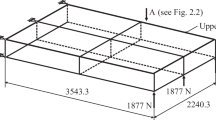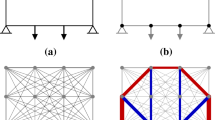Abstract
A multilevel design scheme for ship's hull girders (longitudinal members between two adjacent transverse frames) is presented in this paper. This design scheme handles, very conveniently, the complexity of using an optimization algorithm for such complex design problems having a large number of design variables, nonlinear constraints dealing with different failure modes and interactions among substructures, and nonlinear design objectives. The conventional multilevel design technique is modified by introducing an approach called constraint coordination to increase the probability of achieving the overall optimum very efficiently.
The scheme is demonstrated by application to the structural design of hull girders with simple structural modelling to represent inland waterway ships on which there was a special emphasis in the original research project (Rahman 1991). Three possible panel (consisting of one stiffener and its attached plating) forms; tee stiffened, flat-bar stiffened and corrugated, are optimized to synthesize the hull girder in order to achieve the most efficient structure. The effect of price-structure (labour rate to material price ratio) on the design is also investigated.
Similar content being viewed by others
References
Adamchak, J.C. 1979: Design equations for tripping of stiffeners under inplane and lateral loads.DTNSRDC Report 79/064
Adamchak, J.C. 1982: ULTSTR: a program for estimating the collapse moment of a ship's hull under longitudinal bending.DTNSRDC Report 82/076
Allen, H.G.; Bulson, P.S. 1980:Background to buckling. London: McGraw-Hill
Bleach, F. 1952:Buckling strength of metal structures. New York: McGraw-Hill
Caldwell, J.B. 1955: The strength of corrugated plating for ships bulkhead.Trans. RINA 98, 504–516
Caldwell, J.B.; Woodhead, R.G. 1973: Ship structures: some possibilities for improvements.Trans. NECIES 89, 101–121
Faulkner, D. 1975: A review of effective plating for use in the analysis of stiffened plating in bending and compression.J. Ship Research 19, 1–17
Faulkner, D.; Adamchak, J.C.; Synder, G.J.; Vette, M.F. 1973: Synthesis of welded grillages to withstand compression and normal loads.Comp. & Struct. 3, 221–246
Hughes, O.F. 1983:Ship structural design. New York: John Wiley & Sons
Hughes, O.F.; Mistree, F. 1977: A comprehensive method for the automated optimization of ship structures.Proc. Int. Symp. on Practical Design in Shipbuilding. (held in Tokyo), 35–44
Lee, S.M. 1972:Goal programming for decision analysis. Philadelphia: Auerbach
Lemco, M.M. 1960: Box girder analysis. In: Wah, T. (ed.)A guide for the analysis of ship structures, pp. 410–430
Mesarovic, M.D. 1973: On vertical decomposition and modeling of large scale systems. In: Himmelblau, D.H. (ed.)Decomposition of large scale problems. Amsterdam: North Holland
Mistree, F.; Hughes, O.F.; Phouc, H.B. 1981: An optimization method for the design of large, highly constrained complex systems.Eng. Optim. 5, 179–197
Mistree, F.; Ittimakin, P.; Kuppuraju, N. 1985: An algorithm for solving multiple objective decision support problems in engineering design.Proc. CAD/CAM Robotics and Automation Conf. (held in Tucson, AZ)
Rahman, M.K. 1991:Production-oriented structural design of ships; with particular application to inland waterway vessels. Ph.D. Thesis, University of Newcastle upon Tyne, U.K.
Rahman, M.K. 1992: Structural design of midship cargo hold: rule-based and rational procedures.Proc. PRADS' 92, Volume 2, pp. 2.966–2.980. London: Elsevier Applied Science
Rahman, M.K.; Caldwell, J.B. 1992: Rule-based optimization of midship structures.Marine Struct.; Design, Construction and Safety 5, 467–490
Rawson, K.J.; Tupper, E.C. 1983:Basic ship theory I (3rd. edition). London: Longman
Sen, P.; Shi, W.B.; Caldwell, J.B. 1989: Efficient design of panel structures by a general multiple criteria utility.Eng. Optim. 14, 287–310
Shi, W.B. 1988:Optimization of marine structural form: a multilevel multiple objective design approach. Ph.D. Thesis, University of Newcastle Upon Tyne, U.K.
Smith, C.S. 1983: Structural redundancy and damage tolerance in relation to ultimate ship-hull strength. In:The role of design, inspection and redundancy in marine structural reliability, pp. 91–113 (Proc. Int. Symp., held in Virginia)
Urm, H.S. 1991:Optimum structural design of submersibles. Ph.D. Thesis, University of Newcastle upon Tyne, U.K.
Author information
Authors and Affiliations
Rights and permissions
About this article
Cite this article
Rahman, M.K. Multilevel optimization applied to hull girder design using three panel forms. Structural Optimization 7, 126–137 (1994). https://doi.org/10.1007/BF01742518
Received:
Revised:
Issue Date:
DOI: https://doi.org/10.1007/BF01742518




